



Q. Could you explain what has been revealed by Akari's latest images?
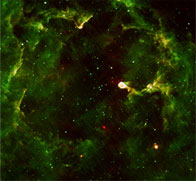 |
 |
| (Figure 1) Akari's image of reflection nebula IC 1396 in the constellation Cepheus |
The regions where a star was born, or is about to be born |
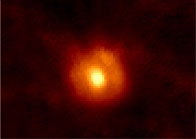 |
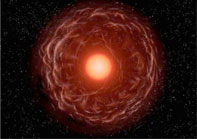 |
| (Figure 2) Akari's image of red giant star U Hydrae |
A red giant star ejecting gas and dust (artist's impression) |
The images clearly revealed details of the process on the birth and death of stars. For instance, we acquired an infrared image of the reflection nebula IC 1396 in the constellation Cepheus (*Figure 1). IC 1396 is located about 3,000 light years away from our solar system. In this region, very massive stars, tens of times the mass of the Sun, are being formed. Eventually, these stars die, causing great explosions called supernovae. When multi-million-year-old stars exploded as supernovae, gas is swept out to the periphery of the nebula, forming a hollow shell-like structure; this phenomenon can be seen near the center of the image. Then the interstellar gas gets compressed and grows dense. This is the region where new stars are born. In Figure 1, the very bright part indicates the beginning of the star formation. In the vicinity of IC 1396, stars are continuously being formed. Akari has captured the first detailed images of the distribution of the ejected interstellar gas and also of the formation of stars in such an environment.
Another image is that of a red giant star U Hydrae (*Figure2), at about 500 light years away from our Sun. As it ages, a star with mass similar to that of the Sun expands dramatically, becomes loose, and starts ejecting gas from its surface into interstellar space. A star in that state is called a red giant. The ejected gas cools as it expands, and dust starts to form from the gas. The mixture of gas and dust keeps expanding outwards. The image shows this kind of cloud at a distance of about 0.3 light years from the central star, after gas was suddenly expelled about 10,000 years ago and dust was formed. The sudden gas explosion is believed to have something to do with the nuclear reaction happening inside the star. New images of Akari will give us crucial information to study this final phase in the life of a star.
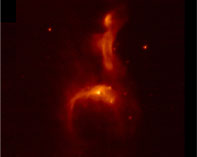 |
| (Figure 3) Akari's image of reflection nebula IC 4954 |
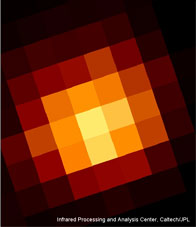 |
| (Figure 4) Reflection nebula IC 4954 observed by IRAS (Courtesy of the Infrared Processing and Analysis Center, Caltech/JPL) |
In addition, during its test observation period, Akari clearly captured a moment of a star being born near the reflection nebula IC 4954 (*Figure 3). This region is about 6,000 light years away from our solar system, and it is believed that new stars have been continually formed over the last several million years. The image shows strong infrared radiation emitted from many spots in the interstellar clouds, which consist of gas and dust, and each spot indicates the birth of a new star. Stars are formed in environments of dense gas and dust. We cannot observe such a location in the visible light, but it is possible in the infrared.
The same region was surveyed in 1983 by the world's first infrared astronomical satellite, IRAS, which was a joint project between the United States, the United Kingdom and the Netherlands. An image captured by IRAS (*Figure 4) shows that there is something in this regions, but it is not quite clear. With Akari's image, though, you can see a totally different world, as if a veil was removed. The power of its high-resolution image capture is obvious.
Astronomers all over the world have congratulated us on the fact that Akari will enable us to perform a radically new all-sky survey. High spatial resolution is vital not just for observing structures in detail, but also for detecting phenomena at much greater distances in the universe.
The Akari's images that have been released so far are only a minor part of the whole Akari's data, and we'll continue to release more in the future. Thanks to all the personnel and organizations in Japan and overseas*, Akari has been able to achieve great success. We expect that more scientific results will be coming soon.
* The Far Infrared Surveyor, one of the focal plane instruments on Akari, was developed primarily by Nagoya University, JAXA, the University of Tokyo and the National Astronomical Observatory of Japan (NAOJ), using detectors provided by the National Institute of Information and Communications Technology (NICT). The other focal plane instrument, the Infrared Camera for near and mid-infrared observations, was developed by the University of Tokyo, JAXA, and other supporting institutes. Operations and data processing for Akari are conducted by the research organizations listed above, and also in international collaboration with the European Space Agency (ESA), the Imperial College London, the University of Sussex, and the Open University in the UK, the University of Groningen and the Netherlands Institute for Space Research (SRON) in the Netherlands, and Seoul National University in Korea.
| 1 2 3 4 |